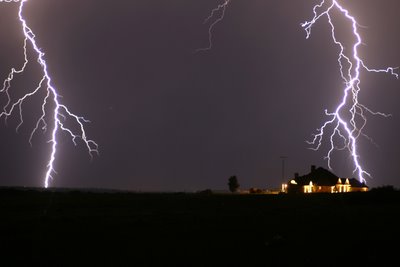


Lightning voltages are usually greater than 20 kV, but can be millions of volts. Researchers and observers have determined that when viewed from a distance, a lightning bolt usually has a question mark shape (?). Most lightning strike occurrences contain multiple strokes. Twenty percent (20%) of these occurrences are only one stroke. Eighty percent (80%) are two or more strokes. The mean stroke occurrence is five to six and the maximum has been measured at twenty-five.
The time between strokes can vary from 100 microseconds to 10 milliseconds during any stroke occurrence.
The current of a lightning strike leader will usually range from 30 to 35 kA. A lightning strike leader is a stream of electrons which appears as a dim spark emerging from a cloud to the ground during the early stages of lightning development. Following the lightning strike leader there may be many multiple-lightning strike occurrences where the average measured lightning strike amplitudes will range from 14 to 40 kA. The duration of the total lightning strike phenomena can have a period between 500 ms and 1 second.
One-third of the second lightning strikes which occurs during multiple lightning strike occurrences are larger in magnitude than the initial strike. The maximum strike intensities (positive and negative) measured were +300 kA and -200 kA. These, however, will occur less than one percent (1%) of the time. The effects of a lightning strike can be measured and the effects felt, 1.2 to 12.5 miles from the strike site. This may be due to lightning currents flowing through the ground. In addition during multiple lightning strikes, the location of the terminating lightning strikes have been observed to vary and may be spaced apart from .2 to 4.5 miles. These data are based on actual measurements. These are long duration current strikes which may last from 10 to 500 ms (30 cycles of 60 Hz lines powers). The amplitude of this long duration strike may range from 10 to 100 amperes and can flow through the power system. This may help to explain why service entrance suppressors sometimes fail during a lightning storm. The long conduction period and the resulting thermal effects can be the consequence of a lightning storm. Since suppressors are transient Voltage devices, the long duration currents may exceed the duty cycle of the device if the device rating is not high enough.






How do you take pictures of lightning it goes SOOOOOOOOOOOOOOO fast????
ReplyDeletehow do you take pictures of lightning it goes SOOOOOOOOO fast?????
ReplyDeleteSo qrazy..
ReplyDeleteOh..
No matter